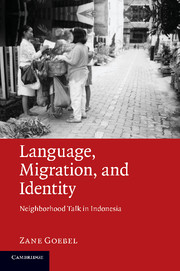Book contents
- Frontmatter
- Contents
- Figures
- Diagrams
- Maps
- Tables
- Extracts
- Preface
- Conventions
- 1 Introduction
- 2 Long-term Processes of Enregisterment
- 3 Enregistering Local Practices and Local Spaces
- 4 Linguistic Signs, Alternation, Crossing, and Adequation
- 5 Women, Narratives, Identity, and Expectations in Ward 8
- 6 Learning to Become a Good Ward Member
- 7 Emerging Identities in a Monthly Ward 8 Male Meeting
- 8 Chineseness as Deviance
- 9 Language Ideologies and Practice in Ward 5
- 10 Conclusions
- Notes
- References
- Index
10 - Conclusions
Published online by Cambridge University Press: 04 August 2010
- Frontmatter
- Contents
- Figures
- Diagrams
- Maps
- Tables
- Extracts
- Preface
- Conventions
- 1 Introduction
- 2 Long-term Processes of Enregisterment
- 3 Enregistering Local Practices and Local Spaces
- 4 Linguistic Signs, Alternation, Crossing, and Adequation
- 5 Women, Narratives, Identity, and Expectations in Ward 8
- 6 Learning to Become a Good Ward Member
- 7 Emerging Identities in a Monthly Ward 8 Male Meeting
- 8 Chineseness as Deviance
- 9 Language Ideologies and Practice in Ward 5
- 10 Conclusions
- Notes
- References
- Index
Summary
Introduction
This book has attempted to fill a gap in scholarship relating to inter-ethnic relations in Indonesia, which has hitherto been primarily historical in nature and not concerned with talk or the local spaces in which it occurs. In particular, I explored how talk figures in mediating social relations in two wards where diversity was the norm and where distinctions between who are newcomers and who are hosts tended to change regularly. I was especially interested in exploring how systems of expectations about behavior were talked about and learned in these wards. Drawing on the insights of Agha (2007), Wortham (2006) and Wenger (1998), I argued that signs from different spatial-temporal settings not only represented resources to be used to identify non-present others and those doing this social identification, but that they also simultaneously figured in the construction of expectations for social conduct within this ward. For example, I noted that in socially identifying someone's behavior as not appropriate in this ward, participants temporally co-constructed what is considered as normal, appropriate and moral behavior.
The multidisciplinary nature of what constitutes current linguistic anthropology/ethnography (e.g. Errington, 1998b; Duranti, 2003; Rampton, 2006; Bucholtz & Hall, 2008) found me not only using multiple methods but also exploring the relationships between the data gathered using these methods. For example, I used work in the area of semiotics, media and cultural studies, and language socialization to theorize and then explore the interdiscursive links between signs from mass-mediated sources, local conversations, and ethnographic observations.
- Type
- Chapter
- Information
- Language, Migration, and IdentityNeighborhood Talk in Indonesia, pp. 191 - 198Publisher: Cambridge University PressPrint publication year: 2010

